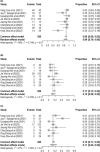Effectiveness and safety of CD22 and CD19 dual-targeting chimeric antigen receptor T-cell therapy in patients with relapsed or refractory B-cell malignancies: A meta-analysis
- PMID: 37667978
- PMCID: PMC10557829
- DOI: 10.1002/cam4.6497
Effectiveness and safety of CD22 and CD19 dual-targeting chimeric antigen receptor T-cell therapy in patients with relapsed or refractory B-cell malignancies: A meta-analysis
Abstract
Background: The efficacy of CD22 or CD19 chimeric antigen receptor T (CAR-T) cells in the management of acute lymphoblastic leukemia (ALL) and non-Hodgkin lymphoma (NHL) was observed. Because antigen loss and lack of CAR-T-cell persistence are the leading causes of progressive disease following single-antigen targeting, we evaluated CD22/CD19 dual-targeting CAR-T-cell therapy efficacy and safety in relapsed/refractory B-cell malignancies.
Methods: The Web of Science, PubMed, Cochrane, and Embase databases were searched until July 2022. Patients confirmed with any relapsed/refractory B-cell hematological malignancies were included regardless of age, gender, or ethnicity, receiving CD22 and CD19-dual-targeting CAR-T-cell therapy. The studies conducted on patients with coexisting other cancer were excluded. We used random-effect models to explore the outcome, and heterogeneity was investigated by subgroup analysis.
Results: Fourteen studies (405 patients) were included. The pooled overall response (OR) and complete remission (CR) were 97% and 93%, respectively, for ALL patients. The 1-year proportions of overall survival (OS) and progression-free survival (PFS) were 70% and 49%, respectively. For NHL, OR occurred in 85% of patients, and 57% experienced CR. The results illustrated that the 1-year OS and 1-year PFS were 77% and 65%, respectively. The subgroup analysis showed that the dual-targeting modality achieved higher CR in the following cases: coadministration of CD22/CD19-CAR-T cells and third-generation CAR-T cells combined with ASCT and BEAM pretreatment. The ALL and NHL groups seemed similar in treatment-related toxicity: all grade cytokine release syndrome (CRS), severe CRS, and neurotoxicity occurred in 86%, 7%, and 12% of patients, respectively.
Conclusions: Our meta-analysis demonstrated that the CD22/CD19 dual-targeting CAR-T-cell strategy has high efficiency with tolerable adverse effects in B-cell malignancies.
Keywords: B cell malignancies; chimeric antigen receptor T (CAR-T) therapy; dual-targeting; efficacy; safety.
© 2023 The Authors. Cancer Medicine published by John Wiley & Sons Ltd.
Conflict of interest statement
The authors declare without conflicts of interest.
Figures





References
-
- Singh AK, McGuirk JP. CAR T cells: continuation in a revolution of immunotherapy. Lancet Oncol. 2020;21(3):e168‐e178. - PubMed
Grants and funding
- MOST110-2320-B038-064-MY3/Ministry of Science and Technology, Taiwan
- MOST111-2314-B038-120-MY3/Ministry of Science and Technology, Taiwan
- MOST111-2320-B038-012/Ministry of Science and Technology, Taiwan
- MOST111-2327-B006-005/Ministry of Science and Technology, Taiwan
- TMU-MSD A-111-112/The industry-academia cooperation program
LinkOut - more resources
Full Text Sources
Medical

